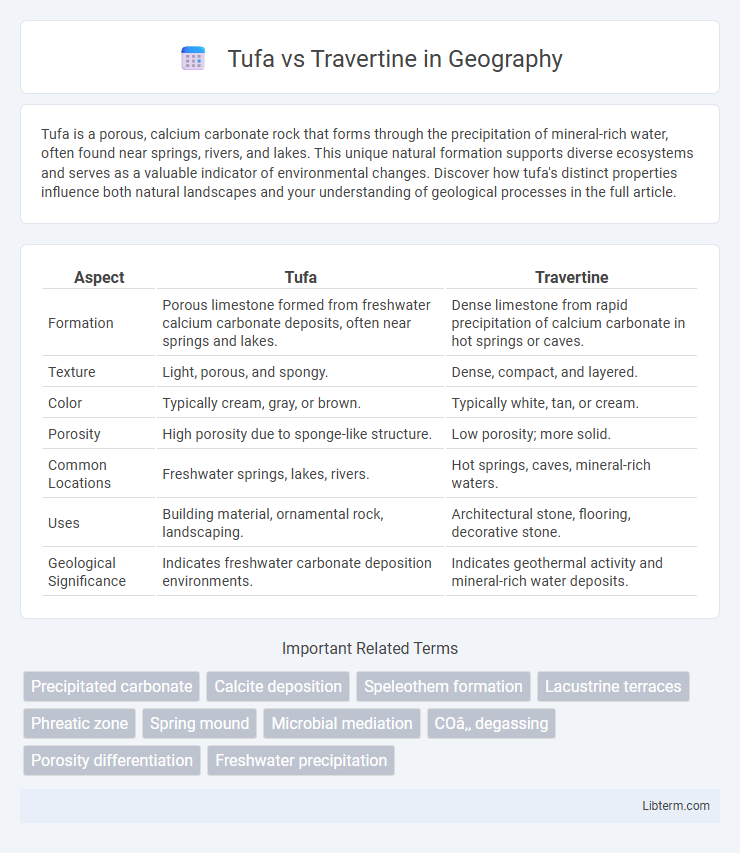Tufa is a porous, calcium carbonate rock that forms through the precipitation of mineral-rich water, often found near springs, rivers, and lakes. This unique natural formation supports diverse ecosystems and serves as a valuable indicator of environmental changes. Discover how tufa's distinct properties influence both natural landscapes and your understanding of geological processes in the full article.
Table of Comparison
| Aspect | Tufa | Travertine |
|---|---|---|
| Formation | Porous limestone formed from freshwater calcium carbonate deposits, often near springs and lakes. | Dense limestone from rapid precipitation of calcium carbonate in hot springs or caves. |
| Texture | Light, porous, and spongy. | Dense, compact, and layered. |
| Color | Typically cream, gray, or brown. | Typically white, tan, or cream. |
| Porosity | High porosity due to sponge-like structure. | Low porosity; more solid. |
| Common Locations | Freshwater springs, lakes, rivers. | Hot springs, caves, mineral-rich waters. |
| Uses | Building material, ornamental rock, landscaping. | Architectural stone, flooring, decorative stone. |
| Geological Significance | Indicates freshwater carbonate deposition environments. | Indicates geothermal activity and mineral-rich water deposits. |
Introduction to Tufa and Travertine
Tufa and travertine are both forms of calcium carbonate deposits formed through mineral-rich water interactions, with tufa typically developing in cooler, freshwater environments and characterized by a more porous, spongy texture. Travertine, often found near hot springs and limestone caves, is denser and exhibits a smoother surface due to rapid precipitation processes. Both stones have distinct geological formations and are widely used in construction and landscaping for their natural beauty and durability.
Geological Formation Differences
Tufa forms through the rapid precipitation of calcium carbonate from ambient temperature water bodies, often influenced by biological activity such as algae, resulting in a porous, lightweight structure. Travertine develops in mineral-rich hot springs or limestone caves through slower deposition of calcium carbonate from supersaturated waters, producing dense, banded, and compact layers. These geological formation differences impact their texture, porosity, and suitability for construction or decorative use.
Physical Characteristics Comparison
Tufa is a porous, lightweight limestone formed by the precipitation of calcium carbonate in freshwater environments, exhibiting a soft texture and low density. Travertine, also a form of calcium carbonate, is denser and harder due to rapid precipitation in mineral-rich hot springs, displaying a fibrous or concentric texture with visible banding. Both stones differ significantly in hardness, porosity, and formation environment, influencing their applications in construction and decoration.
Chemical Composition Overview
Tufa primarily consists of calcium carbonate (CaCO3) formed through the rapid precipitation of carbonate minerals from ambient temperature water sources, often with abundant pores and a softer texture. Travertine is a denser, more crystalline form of calcium carbonate, typically deposited by mineral springs, especially hot springs, and exhibits layered banding due to varying mineral impurities. Both tufas and travertines share a similar chemical composition but differ significantly in formation processes, texture, and porosity.
Common Occurrence Sites
Tufa typically forms near freshwater springs, lakes, and rivers where calcium-rich water precipitates calcium carbonate, often found in regions with volcanic activity such as Italy and the western United States. Travertine commonly occurs in hot springs and limestone caves, characterized by rapid precipitation of calcium carbonate from mineral-rich waters, with prominent deposits in the Mammoth Hot Springs area of Yellowstone National Park and the Tivoli region near Rome. Both rocks are sedimentary carbonates but differ in their depositional environments and geological settings.
Uses in Architecture and Construction
Tufa and travertine are both porous, sedimentary rocks widely used in architecture and construction for their aesthetic appeal and durability. Tufa, often lightweight and easy to carve, is favored for decorative facades, garden walls, and rustic architectural elements, while travertine, known for its dense structure and polished finish, is commonly used in flooring, countertops, and luxurious building cladding. Both materials provide natural insulation properties and weather resistance, making them practical choices for both interior and exterior applications.
Aesthetic and Visual Differences
Tufa features a porous, spongy texture with irregular holes and a matte finish, giving it a natural, rustic appearance ideal for garden accents and outdoor walls. Travertine displays a smoother, more polished surface with consistent banding and a warm color palette ranging from cream to caramel, often used for elegant flooring and countertops. The visual contrast lies in tufa's rugged, volcanic look versus travertine's refined, sedimentary stone patterns.
Durability and Maintenance
Tufa, a porous volcanic rock, tends to be softer and less durable compared to travertine, which is a dense form of limestone known for its strength and resistance to weathering. Travertine's compact structure makes it easier to maintain, requiring less frequent sealing and minimal susceptibility to cracks or erosion. In contrast, tufa's high porosity demands regular sealing to prevent moisture absorption and potential surface damage, leading to higher maintenance efforts over time.
Environmental Impact and Sustainability
Tufa is a porous limestone formed by the precipitation of carbonate minerals from ambient temperature water, making it a naturally renewable resource with minimal environmental footprint due to low-energy formation processes. Travertine, a type of dense limestone deposited by mineral springs, typically requires more intensive quarrying and processing, leading to higher carbon emissions and habitat disruption. Both stones offer durability, but tufa's extraction and renewal cycle present a more sustainable choice for eco-conscious construction and landscaping projects.
How to Identify Tufa vs Travertine
Tufa and travertine can be identified by their formation and texture differences: tufa forms from rapid precipitation of calcium carbonate in freshwater environments, resulting in porous, lightweight, and often softer stone, while travertine forms from mineral springs, typically hot, yielding denser, more layered stone with banded or fibrous textures. Tufa often contains visible plant material or organic impressions due to its slow sedimentation, whereas travertine displays concentric rings or smooth, crystalline surfaces. Color variations in tufa range from light beige to tan, and travertine can include richer hues and more uniform patterns, aiding in visual identification.
Tufa Infographic

 libterm.com
libterm.com